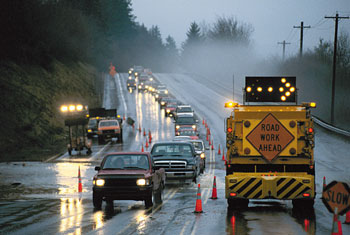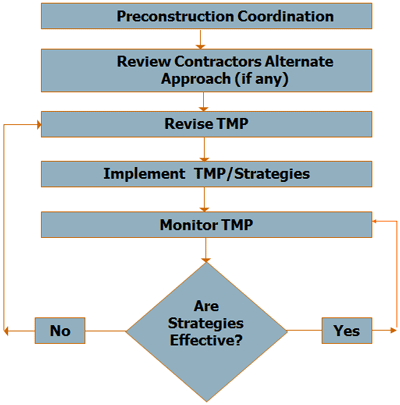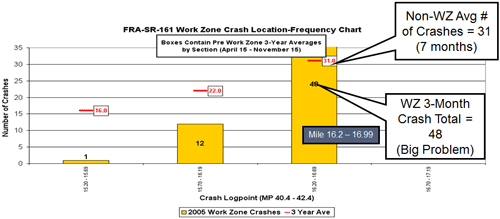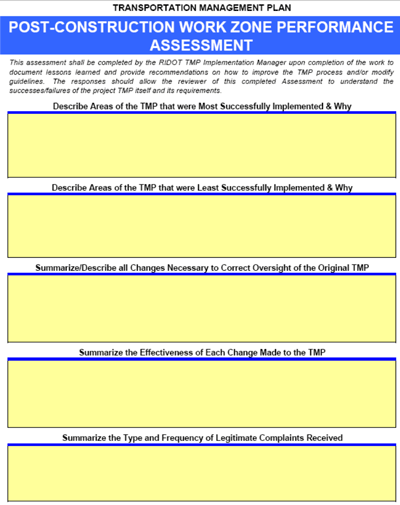Module 6: TMP Approval and Implementation
Printable Version [PDF 18.13MB]
PDF files can be viewed with the Acrobat® Reader®.
Contact Information: WorkZoneFeedback@dot.gov
slide 1
Module 6: TMP Approval and Implementation


narrator notes
This module discusses TMP approval and activities during implementation of the TMP. As discussed in earlier modules, the TMP is a living document, and as construction progresses even the best design can change. Traffic conditions or other factors can also change, resulting in the need to adjust work zone management efforts. In cases where there are substantial changes to the TMP, these should be documented as addendum to the TMP and signed-off by the DOT.
slide 2
About Module 6
- TMP Review and Approval
- TMP Implementation and Monitoring
- TMP Revisions
- Post-Project Evaluation
- Exercise
narrator notes
Module 6 covers TMP review and approval; TMP implementation and monitoring; TMP revisions; and post-project evaluation. Module 6 concludes with an exercise to help you apply what you have learned.
slide 3
TMP Review and Approval
- TMP Review:
- Includes suggestions/comments and feedback on TMP from TMP reviewer(s)
- Can lead to solutions not identified earlier
- Ensures consistency with DOT policy
- Helps with TMP revision and performance monitoring
- Can provide training and sharing of ideas for future projects
narrator notes
Having a step for TMP review by District managers or senior project managers generally leads to more effective TMPs. TMP review may include suggestions and comments from TMP reviewers which can lead to solutions not identified earlier. During TMP review, the reviewers can help make sure that the TMP is developed in accordance with Agency policy and guidelines, leading to greater consistency.
Review efforts may lead to TMP revisions, which can then be done before a project goes to bid, reducing the need for potentially costly changes later. The review process can also provide input to performance monitoring and future training.
slide 4
TMP Review and Approval
- TMP approval:
- Similar to existing Agency procedures for approval of other plans (e.g. TTCP)
- Based on what is written in your Agency's work zone policy
narrator notes
A TMP must be approved before implementation. The process for TMP approval can be similar to your Agency's procedures for approval of other plans such as temporary traffic control plans. Most Agencies have the approval process documented in the formal work zone policy or in a procedures manual.
slide 5
TMP Review and Approval – Example
| Chief Engineer (or designate) | Project Engineer (or designate) | ||||
|---|---|---|---|---|---|
| All approvals must be obtained prior to the start of work | |||||
| Signature: | Signature: | ||||
| Name: | Name: | ||||
| Date: | Date: | ||||
| Revision # | Initials | Date | Revision # | Initials | Date |
| 1 | 1 | ||||
| 2 | 2 | ||||
narrator notes
Each Agency has to determine what approval process works for them. Some States have a formal documented process. Some States include a simple table in their TMP, like the one shown here, for initial sign off and for updates as major changes occur.
slide 6
TMP Review and Approval – Examples
- Oregon – Each region has it own TMP review
- Montana – TMP approval is conducted as part of the PS&E checklist
- California – Signature line for TMP Manager is on project ready-to-list form so TMP is signed off just before project goes to bid
- Maryland – District/relevant central office managers and Public information Officer sign off on TMP
- Rhode Island – Requires Chief Engineer, State Traffic Engineer, and Traffic Management Chief (oversees the TMC) to sign TMP as part of PS&E review
narrator notes
States have different review and approval processes for TMPs. Several States include TMP review and approval as part of the review process for the PS&E package. Some States route the TMP for review separately, either in hardcopy or electronically. There are also variations across Agencies in who is required to review a TMP. A State needs to adopt a process that best suits its needs and achieves the goals of work zone safety and mobility.
slide 7
TMP Review and Approval – Example
- Michigan (MDOT) Peer Review Team for TMPs
- Peer review required for projects exceeding certain criteria
- Team provides feedback to enhance TMP or confirms it is ready to go
- Bonus – Way to share good ideas and learn from other Regions/TMP developers
narrator notes
Michigan DOT has a Peer Review Team that conducts a review of TMPs for significant projects. These projects are ones where the projected work zone delay, level of service, or volume to capacity ratio for the construction conditions would exceed policy thresholds after all reasonable mitigation has been applied. MDOT also does a TMP Peer review for projects where the cost to mitigate impacts to below the thresholds would exceed 25% of the project cost. Projects are submitted to the peer review team after Plan Review and before the errors and omissions check, so the TMP is mostly complete but there is still some flexibility in design and budget.
The review team consists of rotating personnel from MDOT headquarters and the Regions outside of where the project will be located. The team often meets virtually to discuss the TMP after reviewing it, and then provides feedback to the TMP developer. If there are significant concerns, they must be addressed before the project goes forward.
A bonus is that peer reviewers are able to learn from each other and often discover good ideas in the TMPs that they can use on their own future projects.
slide 8
TMP Implementation and Monitoring

narrator notes
Once the TMP is approved and the project is awarded, there may be revisions to the TMP based on pre-construction coordination meetings or any alternate approaches proposed by the Contractor before implementation. Once implemented, the TMP strategies need to be monitored throughout construction and until official "handover" to ensure they are working as intended.
slide 9
Pre-Construction Coordination
- Partnering
- Agency and Contractor work in joint, non-adversarial relationship
- Value Engineering
- Systematic application of recognized techniques by multi-disciplined team
- May lead to TMP Revisions
narrator notes
The two most common approaches used to facilitate Contractor participation are partnering and value engineering. Partnering and value engineering can lead to suggestions for construction changes that can reduce work zone impacts or may increase them. In such cases the TMP may need to be revised and any substantial revisions must be approved by the Agency. Assessing proposed changes and revising the TMP are discussed later in this module.
slide 10
TMP Implementation
- According to 23 CFR 630 Subpart J §630.1012(e):
- The State and the Contractor shall each designate a trained person, as specified in §630.1008(d), at the project level who has the primary responsibility and sufficient authority for implementing the TMP and other safety and mobility aspects of the project.
narrator notes
State and Local Transportation Agencies and the Contractor must have a trained person to implement the TMP. These designated responsible persons need to have primary responsibility for this duty and need to be regularly present at the job site so they can carry out this responsibility. The responsible persons for the Agency and Contractor should have "sufficient authority" to take action, should the work zone strategies be deemed ineffective.
slide 11
TMP Monitoring
- Monitoring TMP performance helps to:
- Assess whether predicted impacts closely resemble actual field conditions
- Gauge effectiveness of TMP strategies in managing impacts
- Document changes and event occurrences during construction
- Determine TMP revisions
- Protect against litigation
- Determine elements to include/correct in future TMPs
narrator notes
The benefits of TMP monitoring and good documentation cannot be overstated. They not only allow you to improve performance over time, but can protect you from unwarranted litigation. Monitoring helps in identifying when adjustments are needed to the TMP strategies deployed on the current project. Monitoring also helps with determining what strategies work well, under what conditions, and any lessons learned to avoid similar mistakes in the future.
slide 12
TMP Monitoring
- What are you monitoring for?
- Recurring congestion (travel time, queue length, etc)
- Crashes within construction limits
- Community and environmental impacts
- Combined issues/impacts with nearby concurrent projects
- TTC Maintenance
- Compliance with contract requirements
narrator notes
Monitoring TMP implementation is important to ensure Contractor compliance with all requirements. The requirements are stipulated to ensure that the work zone is safe and there is minimal interruption of traffic. It is the responsibility of the DOT to provide oversight of the Contractor to ensure compliance with all DOT rules and regulations. It is the responsibility of the Contractor to ensure that they comply with the DOT requirements and to the best extent possible provide a safe and efficient work zone.
The DOT needs to monitor for recurring congestion exceeding the Agency's policy. This can be in the form of travel time, queue length, or any other performance measures set forth in the Agency policy. Impacts could be due to the project work zone itself or due to the combined impact of other projects nearby.
To ensure compliance, the project site must also be monitored for safety, and any deficiencies noted. Personnel should make a note of any crashes that occur within the construction limits and regularly inspect temporary traffic control devices for placement and visibility.
slide 13
TMP Monitoring
- How to monitor
- Field observations
- Floating car studies
- ITS – detectors, sensors
- Traffic management centers (TMCs)
- Record/diary logs
- Public feedback/complaints
- Crash investigations
- Construction and safety inspections
narrator notes
Methods that can be used to monitor the conditions of a work zone include field observations, such as recording traffic control devices that have been regularly knocked over, or queue length and when queues form and dissipate. Sampling using floating car studies, particularly during peak traffic periods, can provide insight on TMP performance. The use of technology, such as permanent or temporary detectors and cameras, can provide real-time measurement of performance and a rich source of data for post-project assessment. Traffic management centers, where available, can be helpful in monitoring.
Diary logs of project events and incidents such as crashes and queue spillover, as well as public feedback or complaints, aid in monitoring both during the project and in performance assessment at the project end. The results of inspections and crash investigations also provide information about performance.
slide 14
TMP Monitoring – Examples
- Lane closures
- Lane closure "start up" and "take down"
- Lane closure implementation vs approval
- Access-egress
- Proper locations and practices
narrator notes
In many urban areas, Contractors are not permitted to close any lanes during peak traffic hours, usually 6:30 to 9:30 a.m. and 3:30 to 6:30 p.m. However, the Contractor may attempt to setup the lane closure prior to 9:30 a.m. or take down after 3:30 p.m. Not only is this an infringement of the contract, but it often severely disrupts peak hour traffic flow. To avoid this, many States have penalty clauses that can range from a few hundred dollars to over five thousand dollars per every 15 minutes of extension into the peak hour. Monitoring can help identify or prevent such issues from occurring.
Sometimes truck deliveries to the site block one or more lanes without prior approval, resulting in an unsafe condition. Monitoring can help identify conditions like this so that unsafe access-egress practices can be addressed.
slide 15
TMP Monitoring – Example
- Near Real-Time Work Zone Crash Data Analysis – Ohio

narrator notes
Ohio DOT breaks a sample of work zones into half-mile segments, sorts crashes into their proper segment, and performs a before-after comparison of the preconstruction and construction crash frequencies for each segment. In this example, preconstruction crash data show that there were an average of 31 crashes for 7 months, or 4.4 crashes per month.
During construction, data gathered every two weeks showed crashes increased significantly to 48 in three months, an average of 16 per month. In such cases, Ohio DOT does a review to determine the contributing circumstances and mitigation treatments to address the issue.
Some additional information is available in the Participant Workbook
Other Information:
More information can be obtained from Presentation by Dave Holstein, Administrator, ODOT Office of Traffic Engineering available at: http://ops.fhwa.dot.gov/wz/decision_support/perf_meas_examples.htm.
slide 16
TMP Revisions
- Assess and consider revising a TMP when:
- Performance measures are not met
- Impacts are unacceptable
- Project changes are proposed/made
- Other issues arise
narrator notes
Monitoring may result in the realization that the TMP is not working as well as planned, or conditions have changed. The TMP needs to be assessed and revised when performance measures are not met, such as if actual queue lengths or delays are not within acceptable limits. If construction changes are proposed that could affect traffic, such as new work activities that alter traffic control requirements, changes to work activity hours, or revised phasing, the TMP may need to be revised. If issues arise such as increased crashes or problems with construction vehicle access, mitigation measures will be needed.
slide 17
TMP Revisions
- Project changes can…
- Affect the MOT decisions made by the DOT during project development
- Increase work zone impacts
- Queues & delays
- Potential for crashes
- Reduce the effectiveness of the TMP
Common issue – good MOT planning is negated by changes at construction
narrator notes
When changes are proposed during pre-construction or construction, it's important to remember that much has happened up to this point. The project should have been identified as significant or not, an assessment of impacts done, and the impacts considered in selecting the preferred alternative for the project. Based on that, the TMP was developed and approved for the project and was included in the PS&E. Then the project was bid and awarded.
After this work and planning has been done, it can all be negated by a bad decision at construction. This is why changes at this stage need to be reviewed for how they will affect the maintenance of traffic and the TMP, before a decision is made whether or not to approve the proposed changes.
slide 18
TMP Revisions
If changes are proposed…
- How will revised impacts be assessed? Who will update the impacts assessment?
- Are any increased impacts acceptable?
- What are the critical issues to address in the TMP?
- Who will update the TMP, as needed?
- Who will pay for these activities?
- Who will pay for any changes in cost to TMP implementation?
narrator notes
There are many TMP-related considerations if changes to the project are proposed at pre-construction or during construction. Any proposed modifications should be assessed for work zone impacts prior to approval. For example, the Contractor may propose alternative phasing to reduce project duration. The Agency should review the phasing changes to determine if they will adversely affect work zone impacts. Would the new phasing result in changes to lane closures that increase queues, or temporary alignment changes that cause access issues?
If changes are needed to the TMP to mitigate increased impacts, the Agency and Contractor will need to negotiate how those costs are paid.
The responsible persons designated for implementing the TMP on the project need to be involved in reviewing any changes that are proposed.
slide 19
TMP Revisions
- Changes/adjustments to TMP may include:
- Traffic control changes
- Re-scheduling work activities
- Additional TTC, TO, and/or PI strategies
- Updates must be approved by the Agency-designated person before implementation
- Design build jobs – TMP is updated usually through amendments
Specify requirement of TMP updates in contract documents for a Contractor-developed TMP (if needed, frequency of updates can also be included)
narrator notes
If substantial changes are made to the project scope, schedule, phasing or other aspects, or the actual work zone impacts are not within acceptable limits, then the project team should take the necessary actions to update the TMP to minimize the impacts. TMP revisions may include changes to the temporary traffic control plan or work activity schedules, or adding or discontinuing other strategies. All TMP revisions must be approved by the Agency before implementation.
In design-build projects, the TMP generally includes guidelines and procedures for strategies like lane closures, detours, and public notification. For these projects, TMP changes are usually done through amendments that include adjustments to various strategies.
slide 20
Post-Project Evaluation
- TMP Monitoring/Revisions (project level)
- Post Project Evaluation (project level)
- Process Review (agency-wide)

narrator notes
The findings from TMP Monitoring and any TMP changes, as well as any post project evaluations done, should be recorded. Some Agencies prepare an evaluation report at the completion of significant projects. These records can help the Agency better develop TMPs in the future.
The results of TMP evaluations from several projects across the State or at the District level are useful while doing a Process Review. A process review is required every 2 years by the Work Zone Safety and Mobility Rule and is intended to help improve work zone policy and procedures, including TMP development and implementation.
slide 21
Post-Project Evaluation
- Elements to consider for post-project evaluation include:
- Overall statement reflecting TMP usefulness
- Areas of TMP effectiveness
- Changes to original TMP and results of those changes
- TMP failures
- Public reaction to the TMP
- Lessons learned
narrator notes
The main emphasis of post-project evaluation it to note what worked well and what did not. In addition to an overall assessment of how well the TMP worked, it is helpful to make notes about which TMP strategies worked well based on monitoring results and the reaction from the public and other stakeholders. Notes about TMP changes made, how effective they were, and whether the process worked smoothly are also a good idea. Sometimes the most useful information to future TMP developers is lessons learned.
slide 22
Post-Project Evaluation – Example
- Michigan (MDOT)
- Crash data analysis
- Mobility performance analysis
- Travel time runs
- Portable trailers with sensors
- Compiled into regional and Statewide measures
narrator notes
Michigan DOT measures work zone performance, specifically in the areas of work zone crashes and travel time. Crash data is retrieved through the Transportation Management System (TMS) database. Performance can be presented as total numbers of crashes as well as a detailed breakdown of crashes on a project-by-project basis.
Travel time is determined through various methods such as real-time measurement of vehicle speeds and occupancy using portable trailers with sensors that are rotated between work zones. Michigan DOT also uses co-op assistance from students for data collection, such as driving through work zones to measure queues and record delay time. Michigan DOT combines the project mobility data into regional and Statewide measures of the percent of its work zones meeting mobility goals.
slide 23
Post-Project Evaluation – Example
- Rhode Island (RIDOT) Template

narrator notes
Rhode Island DOT uses a template to document its post construction assessment. The template includes lessons learned and recommendations on ways to improve the TMP process or modify guidelines. The template is filled in by the TMP implementation manager upon the completion of the project.
slide 24
Exercise
narrator notes
Now that you have completed Module 6, this exercise will provide you with an opportunity to apply what you have learned.
slide 25
Exercise Questions
Turn to page 197 in the Participant Workbook for the exercise
- Why is it important to monitor the TMP when this project is under construction?
- If the contractor proposes to accelerate the construction schedule via additional lane closures and/or extension of lane closure hours:
- How might this affect the TMP?
- Who should be involved in reviewing and approving the changes?
To access the Participant Workbook, visit: http://www.ops.fhwa.dot.gov/wz/resources/final_rule/tmp_examples/tmp_training/tmp_workbook.pdf.
narrator notes
Please turn to page 197 in Appendix C in the Participant Workbook. After reading the exercise, please answer the questions on this slide.
slide 26
Exercise Discussion
Turn to page 209 in the Participant Workbook for a discussion of the exercise answers
narrator notes
Once you have completed answering the questions, turn to page 209 in the Participant Workbook for a discussion of the exercise answers.
previous | next